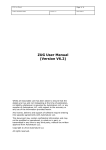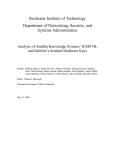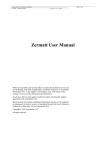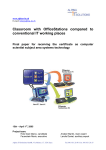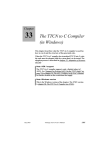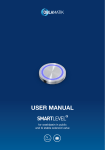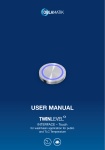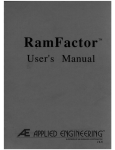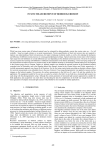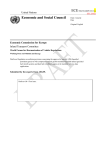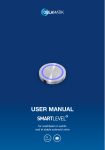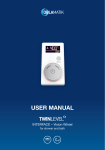Download ZUG User Manual (Version V5.0)
Transcript
Page 1/ 28
ZUG User Manual
Author: Sankha Sil
Version: 4.4
ZUG User Manual
(Version V5.0)
Whilst all reasonable care has been taken to ensure that the details are true and
not misleading at the time of publication, no liability
whatsoever is assumed by Automature LLC, or any supplier of
Automature LLC, with respect to the accuracy or any use of
the information provided herein.
Any license, delivery and support of software require entering
into separate agreements with Automature LLC.
This document may contain confidential information and may
not be modified or reproduced, in whole or in part, or
transmitted in any form to any third party, without the written
approval from Automature LLC.
Copyright © 2012 Automature LLC
All rights reserved.
Date 20/06/12
Page 2/ 28
ZUG User Manual
Author: Sankha Sil
Version: 4.4
Date 20/06/12
Revision History
Version
Date
Name
Description of Changes
1.0
2010-09-23
Nitish Rawat
First Edition
1.1
2010-11-04
Nitish Rawat
Revised Edition with illustrative snapshot and new chapters
1.2
2010-11-09
Nitish Rawat
Changes in section ordering
2.2.2
2011-08-30
Sankha Sil
Changes in Atom path, new Option and Features
2.3
2011-09-16
Sankha Sil
Changes in Relative Path and Command Line Macro Value Passing
3.0
2012-01-09
Sankha Sil
New Feature added. Zug uses methods which are dynamically loaded
3.2
2012-03-25
Sankha Sil
New Feature added Zug have Configuration Management for MVM
4.0
2012-03-29
Sankha Sil
New Feature added Zug Reports Results uisng Davos
4.3
12-06-12
Dipayan Sengupta
New Features : BuildTag and TestPlan added
4.4
20-06-12
Dipayan Sengupta
New Feature :TopologySet
Page 3/ 28
ZUG User Manual
Author: Sankha Sil
Version: 4.4
Contents
Table of Contents
1. Introduction.....................................................5
1.1 Document Purpose....................................................5
1.2 Intended Audience.....................................................5
2. Concepts and Terminologies............................6
2.1
2.2
2.3
2.4
2.5
2.6
2.7
2.8
2.9
Test Suite.................................................................6
Test Case..................................................................6
Atom.......................................................................6
Molecule...................................................................6
Action......................................................................6
Test Plan..................................................................6
Test Step..................................................................6
Verification Step........................................................7
MVM Configuration.....................................................7
3. ZUG Options.....................................................8
3.1 -TestCaseID=Test001,................................................8
3.2 -Repeat | -NoRepeat..................................................8
3.3 -Autorecover | -NoAutorecover....................................8
3.4 -Verbose | NoVerbose................................................8
3.5 -Debug | NoDebug.....................................................9
3.6 -Verify | -NoVerify.....................................................9
3.7 -AtomPath=<location>..............................................9
3.8 -Include=<location>..................................................9
3.9 -Execute | -NoExecute...............................................9
3.10 -$<macroname>=<value> ......................................9
3.11 -TestCycleID=<integer>...........................................9
3.12 -TestPlan=<Product:Release:Sprint:TestPlan>...........10
3.13 -TopologySetID=<integer>.....................................10
3.14 -TopologySet=<AlphaNumeric>...............................10
3.15 -BuildTag=<AlphaNumeric>....................................10
4 ZUG Modes......................................................11
4.1 Production Mode......................................................11
4.2 Developer Mode.......................................................11
4.3 Performance Mode...................................................11
5 Process Flow...................................................13
5.1 Architecture overview...............................................13
6 Running your first automated test..................14
6.1
6.2
6.3
6.4
6.5
6.6
6.7
Preparing Zermatt for Zug........................................14
Managing Atoms......................................................14
Preparing Zug for Zermatt........................................15
Executing the automated test....................................16
Viewing results in Zermatt........................................21
Interpreting the results............................................21
Archival the Log files................................................24
Date 20/06/12
Page 4/ 28
ZUG User Manual
Author: Sankha Sil
Version: 4.4
7. Troubleshooting.............................................25
7.1
7.2
7.3
7.4
7.5
Debug Log..............................................................25
Primitive log............................................................25
Database connection problem....................................25
Unable to Archive Log Files.......................................26
License Expired.......................................................26
8 ZugINI.xml Inprocess atoms configuration.....27
Date 20/06/12
Page 5/ 28
ZUG User Manual
Author: Sankha Sil
Version: 4.4
Date 20/06/12
1. Introduction
Zug is Automature’s software test automation tool. Zug provides an execution environment for tests
specified using a high level test specification language namely CHUR. Zug is platform independent,
and can be used on any environment that supports the Java Runtime Environment.
1.1 Document Purpose
The user manual explains you operation of Zug options. You will be able to use several options for
customizing the execution of test cases.
1.2 Intended Audience
The user manual is intended for users who want to learn or run execution of test suites. Test suites are
written in Chur. The test suite file is given as input to Zug.
Page 6/ 28
ZUG User Manual
Author: Sankha Sil
Version: 4.4
Date 20/06/12
2. Concepts and Terminologies
2.1 Test Suite
As explained before Test Cases are individual programs designed to test a feature of a product. As
there are usually hundreds or thousands of features in a single application, therefore the number of
Test Cases would be equally high. To manage so many of them, Test Cases are grouped into Test
Suites.
2.2 Test Case
A Test Case is a program whose purpose is to test a certain feature of a product. It tells the developer
(or whoever else is trying to make the product work) whether the feature is working properly by
verifying the results and if not, help them identify the cause of the malfunction.
The Automature Framework has a hierarchical structure in which Test Cases are at the core of it.
2.3 Atom
Atoms are the smallest unit of action in Chur. They are entities, such as programs or scripts that can be
executed at the command line level in a shell (e.g. the Command Prompt in Windows). Atoms can be
invoked on the Test Cases or Molecules worksheets in the Test Suite spread sheet on a single line. An
example of an atom can be a program that enters text into a form field inside a web page, or can
simulate a button click.
2.4 Molecule
Molecules are a collection of atoms in a sequence, with the added ability to express more complex
logic. Molecules may call atoms directly, or through other nested molecules. Test Cases, themselves
could be considered Molecules themselves, except that no other test case or molecule can call them.
Example of a molecule can be to simulate a user login, by using the atom examples above.
2.5 Action
A test case is a sequence of one or more Actions. Each Action may take as many arguments as
necessary. An Action atom is expected to return an exit status code that implicitly tells Zug if the
action was successful. By convention a non-zero status is interpreted as a failure. When Zug
encounters a failure status it automatically invokes the appropriate clean up steps.
2.6 Test Plan
Test plan is the comprehensive planning of how features can be tested with the respective test cases in
certain topology sets. Each test plan may contain one or more test cycles which may be executed
during the course of a certain phase of the product.
2.7 Test Step
A Test Step should be specified for each Action of a test case or a Molecule but not for a Verification
Step. It should be monotonically increasing number for each test case action. If two steps of a test case
have the same steps, then the two steps are executable concurrently. Some of these steps can be
considered as initialization steps, few others the action steps and the rest as cleanup steps.
Page 7/ 28
ZUG User Manual
Author: Sankha Sil
Version: 4.4
Date 20/06/12
2.8 Verification Step
Each Action of a Test Case may consist of none, or several Verification methods. And each
Verification method may take several arguments as needed. A verification atom is expected to return
an exit status code that implicitly tells Zug if the verification was successful. By convention, a nonzero status code is interpreted as a failure. When Zug encounters a failure status in verification, it
automatically invokes the corresponding clean up steps.
2.9 MVM Configuration
While running any testcase if it contains more than a certain level of multivalued macro it may fail due
to java jvm max memory which is not sufficient for keeping that many Cartesian producted testcases.
Due to low machine configuration it fails but it can run in high configuration machines. As so from
Zug3.2 version this configuration dependency is introduced in ZugINI.xml as <configuations> tag.
Under that tag there is another type tag <mvm-configurationjvm-max-memorysize="853">. This
name attribute of this tag mainly identifies the machine JVM memory configuration, which helps to
find out what is the JVM max memory it can avail. Under the tags the mvm cardinality is defined
which have the number of cardinality of testcases. Cardinality: the total testcases generated by Zug
doing Cartesian /indexed expansion over the number of MVMs in the testcase.
Below is a example of a configurations tags in ZugINI.xml.
<configurations>
<mvm-configuration jvm-max-memorysize="853">4000</mvm-configuration>
<mvm-configuration jvm-max-memorysize="455">3000</mvm-configuration>
<mvm-configuration jvm-max-memorysize="247">2500</mvm-configuration>
<mvm-configuration jvm-max-memorysize="122">1500</mvm-configuration>
</configurations>
Page 8/ 28
ZUG User Manual
Author: Sankha Sil
Version: 4.4
Date 20/06/12
3. ZUG Options
Zug has a set of standard options that are supported in the execution test environment. The syntax the
launching Zug is as follows:
RunZUG.bat [options] FILE.xls
3.1 -TestCaseID=Test001,...
If -TestCaseID is specified, Zug will execute only specific test cases as listed and will ignore the rest.
The value to be specified is comma separated list of Automated Test Case Ids. This option is not
required. By default all test cases specified in the input file are executed.
3.2 -Repeat | -NoRepeat
The -Repeat option allows the user to run a selection of test cases repeatedly, for a specified duration,
or a specified number of iterations. The Longevity tests run the test plan setup and cleanup only once,
and record a single result as the outcome.
Note: Zug debug logs are turned OFF during LONGEVITY MODE to ensure Zug does not consume
too much disk space. By default, -NoRepeat is selected.
-Count=integer
This option specifies number of times the test cases mentioned in the test plan will be executed in
iteration. This should be a number.
Example: -Repeat -Count=5
-Duration=time
This option specifies how long the test cases mentioned in the test suite will be iterated through.
The time value has to specified in
•[days]d
•[hours]h
•[minutes]m
•[seconds]s
Example: -Repeat -Duration=3d
Note: -Duration and -Count are mutually exclusive. If both of them are specified on the command
prompt, then -Count takes precedence over -Duration.
3.3 -Autorecover | -NoAutorecover
The option -Autorecover specifies Zug to run cleanup during test plan/test step timeout or failure. By
default, -Autorecover will be selected unless specified otherwise. If -NoAutorecover is specified, then
there are no cleanup steps to execute.
3.4 -Verbose | NoVerbose
The option -Verbose is used to display debug messages on the output console. By default -NoVerbose
will be selected unless explicitly mentioned. The option -NoVerbose does not display any debug
messages on the output console.
Page 9/ 28
ZUG User Manual
Author: Sankha Sil
Version: 4.4
Date 20/06/12
3.5 -Debug | NoDebug
The -Debug option is specified to run the Automation in Debug Mode. In this case if any atom is not
implemented then the Zug will prompt with a default atom. By default -NoDebug will be selected
unless explicitly disabled.
3.6 -Verify | -NoVerify
The option -Verify specifies Zug to execute the testcase without verification. By default, -Verify is
selected means ZUG will run verification actions for each testcase unless explicitly -NoVerify is
specified.
3.7 -AtomPath=<location>
This option specifies the location from where ZUG will pick up atoms for Test Automation/Execution.
This should be a fully qualified location and should not be a relative path. We can give multiple
locations by ; separator.
Example: -Atompath=C:\Tests\Atoms
3.8 -Include=<location>
This option specifies the location from where ZUG will pick up molecules for Test
Automation/Execution. This should be a fully qualified location and should not be a relative path. We
can give multiple locations by ; separator.
Example: -include=C:\Tests\Molecules
3.9 -Execute | -NoExecute
-NoExecute mode will verify if the Test Design Excel sheet prepared by the user is syntactically
correct or not. By default -Execute mode is selected unless explicitly specified. If -NoExecute is
selected, Zug will just validate the test suite design sheet, display a list of errors, and exit without
executing any test cases in the test suite.
3.10 -$<macroname>=<value>
-$$<macroname>={<value1>,<value2>}
This option specifies the macro value of the macro in the chur sheet. If the macro name is not written
in the macro sheet of the chur spread sheet then it will add one while it is passed in the command line.
The macro name should not contain any blank space and the macro value should not contain any
blanks also. The macro value should be normally passed without giving any “”(quotes). Multi valued
macro is also can be passed by providing the braces({}). It is also possible in providing of macro value
as {1..2} for extended macro values.
3.11 -TestCycleID=<integer>
Use Zermatt to look for TestCycleID. If it is not provided then Zug will generate a new ID and update
the results under it. By default, Zug always generates a new testcycle in ZERMATT unless explicitly
specified to use an existing TestCycleID. TestCycleID can be found in ZERMATT page navigating to
Test Cycle Report.
TestCycleID
Page 10/ 28
ZUG User Manual
Author: Sankha Sil
Version: 4.4
Date 20/06/12
Example: -TestCycleID=72
3.12 -TestPlan=<Product:Release:Sprint:TestPlan>
This is required to upload test case execution results in Zermatt under a particular Test Plan. Instead of
using the testplanid, you can also report to Zermatt by naming the testplan in the following way:
Example: -TestPlan="ZUG:First Release:rc7 sprint:Smoke test plan"
3.13 -TopologySetID=<integer>
This is required by Zug to register results in a testcycle for the specified Topology Set. The Topology
Set has to be written in Zermatt and its id is to be specified. The Topology Set Id can be seen in the
Zermatt page as shown below in the status bar of List all Topology Sets for a chosen Test Plan:
TOPOLOGYSET_ID
Example: -TopologySetId=26
3.14 -TopologySet=<AlphaNumeric>
Instead of using the topologysetid, Zug can register results in a testcycle by specifying the name of the
topologyset. The topologyset set associated with the test cycle should be stated while running zug.
Example: -topologyset="First TopologySet"
3.15 -BuildTag=<AlphaNumeric>
This is required by Zug to upload the name of the Build in Zermatt for a particular sprint. You can
report to Zermatt by naming the BuildTag in the following way:
Example: -BuildTag=Build074
Page 11/ 28
ZUG User Manual
Author: Sankha Sil
Version: 4.4
Date 20/06/12
4 ZUG Modes
4.1 Production Mode
In production mode the tests are run and result are registered in Zermatt. This is done for unattended
testing.
The following options are primarily used to design in this mode:
•
-NoRepeat
•
-AutoRecover
•
-NoVerbose
•
-Verify
•
-Execute
•
-TestCycleID=[integer]
•
-TestPlanID=[integer]
•
-TestPlan=[String:String]
•
-TopologySetID=[integer]
•
-TopologySet=[String]
•
-BuildTag=[String]
The above options are discussed in detailed in Chapter 3: . ZUG Options.
4.2 Developer Mode
In this mode Test Automation Developer can debug the automated scripts
The following options are primarily used to design in this mode:
•
-Verbose
•
-Debug
The above options are discussed in detailed in Chapter 3: . ZUG Options.
4.3 Performance Mode
This mode is done to stress and measure performance parameters, values and attributes.
The following options are primarily used to design in this mode:
•
-Repeat
•
-NoVerify
•
-Execute
•
-TestPlanID=[integer]
•
-TopologySetID=[integer]
The above options are discussed in detailed in Chapter 3: . ZUG Options.
Page 12/ 28
ZUG User Manual
Author: Sankha Sil
Version: 4.4
Date 20/06/12
Page 13/ 28
ZUG User Manual
Author: Sankha Sil
Version: 4.4
Date 20/06/12
5 Process Flow
5.1 Architecture overview
The atoms written in any scripting language are executed in Zug platform with the help of Chur spread
sheet in different Zug machines. After execution the results are stored in the data repository of
Zermatt. The end-users can access the results in Zermatt through the internet at real time.
Page 14/ 28
ZUG User Manual
Author: Sankha Sil
Version: 4.4
Date 20/06/12
6 Running your first automated test
In this manual we are using an example for illustration where we open a document using an office
application and close it automatically.
(If you are not using Zermatt, then kindly ignore the following sections
6.1)
6.1 Preparing Zermatt for Zug
•
Once the test plan is created in Zermatt, it can be used to store automated test results. The
testplan_id of the test plan is one of the inputs required by Zug to file the results. The
testplan_id can be found in Zermatt.
•
The topology sets are also needed to be written in Zermatt for integration with Zug. The
topology sets has to be added to the list of topology sets of the test plan. The topology set
written should have at least one topology. The topologyset_id is found in the status bar of List
all Topology Sets for a chosen Test Plan.
•
We can see the participating topologies of the topology set in the Zermatt page List All
Topology Sets:
•
The role of any one topology as shown in the above figure should match with the role stated in
the Chur spreadsheet that is to be written later.
(For deeper understanding on CHUR, please refer to the Language Reference Manual of Chur)
6.2 Managing Atoms
The atoms in Zug can be written in any scripting or programming language. In this manual we have
created the atoms using AutoIT, a freeware BASIC-like scripting language designed for automating
the Windows GUI and general scripting. For web based products, we have our own proprietary
libraries named Zuoz. For more information regarding Zuoz kindly refer to
www.automature.com.
The demo atoms are written in AutoIT and stored in a folder inside the Input files folder of the Zug
Kit.
Page 15/ 28
ZUG User Manual
Author: Sankha Sil
Version: 4.4
Date 20/06/12
6.3 Preparing Zug for Zermatt
Once the atoms are written, the Chur spread sheet is prepared. For more information on how to write a
Chur file please refer to the Language Reference Manual of Chur.
The figure below shows the configuration page of Chur file for this test.
The Config page states the environmental information which is used by Zug to locate supporting
programs and uploading results into the database.
•
ScriptLocation states location of the folder where the Zug atoms are written for this test.
•
DBHostName states the hostname for the database server. To keep the data repository of
Zermatt in the Zug machine, localhost is given as input. We can provide the exact port
number also for reporting.
•
DBName states the database name.
•
DBUserName states the name of the user to do authentication to database.
•
DBUserPassword states the password of the user required for SQL authentication.
•
Test Suite Name states the name of the test suite which was stated in Zermatt.
•
Test Suite Role states the role of the node where Test Suite will be executed.
The figure below shows the macros page of Chur file for this test.
Page 16/ 28
ZUG User Manual
Author: Sankha Sil
Version: 4.4
Date 20/06/12
The macros allow the testcase designer to declare short names that can then be substituted in the
testcase descriptions during execution. In this case, the path of the file Test.doc is given as input.
6.4 Executing the automated test
Time has come to execute the automated test in Zug. While executing, the test cycles will be
incremented in Zermatt automatically. Before executing, the Zermatt page will look as shown in the
figure below.
Topology Set
associated with
this test plan
•
Open the command prompt.
Page 17/ 28
ZUG User Manual
Author: Sankha Sil
Version: 4.4
Date 20/06/12
•
Type runzug "C:\ZUG\Input Files\Demo.xls" -testplanid=61
-topologysetid=1 –verbose
•
The following screens will appear automatically. The automation starts....
Page 18/ 28
ZUG User Manual
Author: Sankha Sil
Version: 4.4
•
The atom named STARTAPP.EXE is called to execute.
•
The Word Application is opened.
Date 20/06/12
Page 19/ 28
ZUG User Manual
Author: Sankha Sil
•
Version: 4.4
Date 20/06/12
The Word file is opened by executing the OPENFILE.EXE.
•
•
After the Word file is opened, the CloseFile and the ExitFile executable files are called which
closes the Word file and then exits from the Word application.
•
The following screens appear on the command prompt which gives the result of the automated
test.
Page 20/ 28
ZUG User Manual
Author: Sankha Sil
Version: 4.4
Date 20/06/12
The detailed explanation will be stated in the following section 6.5-6.5 Viewing results in Zermatt.
Page 21/ 28
ZUG User Manual
Author: Sankha Sil
Version: 4.4
Date 20/06/12
6.5 Viewing results in Zermatt
•
You will see that the test cycle is automatically increased to one. Refer to section Executing
the automated test to see the previous value of test cycle. Now every time you run Zug, the
value increments by itself.
6.6 Interpreting the results
Results in Command Prompt
The progress of the test-cases are displayed one after another. The specified Action and Verification
Steps inside the test cases are executed and are shown at the same time in the command prompt. If any
step fails then the exception message is displayed explaining the cause of failure.
At the end the brief result are shown in tabular form. The table has columns TestCase ID, status, Time
Taken, Comments.
TestCase ID
The identifier of the test-cases which ran inside test suite
status
Pass/Fail
Time Taken (milli seconds) Milliseconds taken to execute the test case
Comments
On failing, this states the exception message with the reason of failing
Page 22/ 28
ZUG User Manual
Author: Sankha Sil
Version: 4.4
Date 20/06/12
Results in Log Files
Zug will generate four types of Logs. These logs will be created inside the AppData Folder
(Application Data folder of windows OS) of logged in user.
All the Log File Name will be appended with a Date Time. For example Debug log will be named as
2008128-163637543-Debug.log (format is yyyymmdd-hhmmssmillisecond-debug) which means that
this Debug Log is created on 8th December 2008 at 16 hours 36 minutes (last 5 are seconds and milliseconds). Following is the description of the log files 1."Result.log" - This log will contain the result of the test case, It will contain the status of the
action(s) specified in the TestCase worksheet and also the appropriate error result if any error
thrown during the test case series execution.
2."Debug.log"- This log will contain all the debug related messages.
3."Error.log"- This log will contain the error and warning messages if any error occurred during
the execution.
4."Primitives.log" - This log will contain Logs from the Atoms during atom execution.
Viewing the test results from Zermatt:
To view the results in Zermatt, navigate to the page where the test plans are written. As said earlier, the
test cycle is incremented from 0 to1.
Page 23/ 28
ZUG User Manual
Author: Sankha Sil
Version: 4.4
Date 20/06/12
View
Click on View and you will be able to see the following page. It states the time and the date of the
initialization and completion of the test cycle.
If you navigate into the topology set of that test plan, the test execution results are shown. It stated that
the test has passed and also the duration and the date of the test execution.
If you navigate to the Dashboards, the various kinds of results that might be possible is shown in
various formats. For further information regarding dashboards, kindly refer to Zermatt User Manual.
Page 24/ 28
ZUG User Manual
Author: Sankha Sil
Version: 4.4
Date 20/06/12
6.7 Archival the Log files
Zug supports log archiving. If Zermatt integration is used then Zug will archive the log. Zug will
archive two types of logs:
•Tested product (like LMDC Client, Server) log files. Log file specified in Config sheet of Test design
sheet. This is done by specifying ProductLogLocations in the Config sheet of Chur Test Suite.
•Zug created log files (Debug, Error, Result).These are the log files which are generated by the Zug
during test plan execution.
Log Archival Setup
You can specify Archive Location in the Zermatt Configuration Page:
Page 25/ 28
ZUG User Manual
Author: Sankha Sil
Version: 4.4
Date 20/06/12
7. Troubleshooting
7.1 Debug Log
Zug generates different log file. Debug file stores messages which contain extensive contextual
information. They are mostly used for problem diagnosis. In failures this file can be referred back to
diagnose and investigate problems, exception. The step-by-step execution messages are appended
during Zug automation. The file can be browsed through and
7.2 Primitive log
Zug executes Atoms. To learn how to write Atom please refer to Automature's Zuoz Programmer's
Guide. Inside Atoms some logging command mechanism can be used to help future diagnosis of Atom
execution. The Atom Logs are stored in Primitive Log File. In failures this file can be referred back to
diagnose and correct Atoms
7.3 Database connection problem
In order to integrate test results with Zermatt there should be establishment of proper database
connection. You can allow access to certain machines for the specified user connection. Do database
user administration to add and modify users permission. Put proper connection details in preparing
Zug for Zermatt. Refer Page 15 6.3 Preparing Zug for Zermatt
Page 26/ 28
ZUG User Manual
Author: Sankha Sil
Version: 4.4
Date 20/06/12
7.4 Unable to Archive Log Files
Archiving of Log files are done on location specified in Configuration (Refer page 24 6.7 Archival the
Log files) Zug machine should be given proper write-permission for the location specified. An
exception can occur as following:
7.5 License Expired
License can expire under the two following cases
1.You are using an expired license. Each license has a certain validity period and it expires on a
particular date as mentioned.
2.You are using an improper license. The license may be incorrect or intended for other use.
Page 27/ 28
ZUG User Manual
Author: Sankha Sil
Version: 4.4
Date 20/06/12
8 ZugINI.xml Inprocess atoms configuration
Zug3.0 version can call the external java jar files as built-in atoms through chur spreadsheet. To make
this happen the ZugINI.xml parsing is needed. Inside the Zug installation directory, the ZugINI.xml
file can be edited to by putting the values in the tags of
<inprocesspackages>
<inprocesspackage name="" language=””>
<file-path></file-path>
<jar-package></jar-package>
<class-name></class-name>
</inprocesspackage>
</inprocesspackages>
This xml file (ZugINI.xml) is in ZUG installation folder.
For any Java inprocess atoms, the inprocesspackage tag contains file-path,jar-package and class-name
tags.
Example:
<inprocesspackages>
<inprocesspackage name="Zbrowser" language=”Java”>
<file-path>C:\Programfiles\Automature\ZUOZ\Builtins</file-path>
<jar-package>com.automature.zuoz.builtins.zbrowser</jar-package>
<class-name>BrowserOperations</class-name>
</inprocesspackage>
</inprocesspackages>
For any C++ dll atoms the same inprocesspackage tag will contain different tag values example the language tag will be changed to “JNI”. The file-path tag will specifies the dll. The dll-name tag
specifies the name of DLL file.
Example:
<inprocesspackages>
<inprocesspackage name="JNIDLL" language=”JNI”>
<file-path>C:\Programfiles\Automature\ZUOZ\Builtins</file-path>
<dll-name>TestDLL</dll-name>
</inprocesspackage>
</inprocesspackages>
For any COM dll atoms the Program ID is needed.
For the same inprocesspackage tag, language attribute value will be “COM” and there will be one
additional tag as prog-id.
Page 28/ 28
ZUG User Manual
Author: Sankha Sil
Version: 4.4
Example:
<inprocesspackages>
<inprocesspackage name="ZCOM" language=”COM”>
<prog-id>Automature.Pioneer</prog-id>
</inprocesspackage>
</inprocesspackages>
For further problems visit ZUG Forum.
Date 20/06/12




























